Of all the exotic destinations I've visited across several continents and countries, I can’t recall a more scenic locale offering such splendid isolation writes Yoginder Sikand, of Pulau Samosir and the island resort of Tuk-Tuk
In a previous despatch to these pages (EW July) I had described my travels (and travails) in Penang (Malaysia) which I explored for over a fortnight. The despatch ended with my arrival in Sumatra and in particular, in the tiny settlement of Tuk-Tuk.
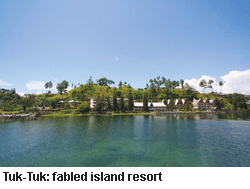 After exploring sumatra, the largest of Indonesia’s 17,000-plus islands, for over a week and traveling from the port city of Medan to the mountain resort of Berastagi, my next destination was the fabled island resort of Tuk-Tuk, set on an island in the middle of an enormous lake in the crater of an extinct volcano. I planned to spend a fortnight there writing and relaxing. A friend of mine who had been to Tuk-Tuk insisted that I had to include this island resort in my itinerary. His commendation included the information that he had intended to spend just two days in Tuk-Tuk but ended up staying for three weeks.
After exploring sumatra, the largest of Indonesia’s 17,000-plus islands, for over a week and traveling from the port city of Medan to the mountain resort of Berastagi, my next destination was the fabled island resort of Tuk-Tuk, set on an island in the middle of an enormous lake in the crater of an extinct volcano. I planned to spend a fortnight there writing and relaxing. A friend of mine who had been to Tuk-Tuk insisted that I had to include this island resort in my itinerary. His commendation included the information that he had intended to spend just two days in Tuk-Tuk but ended up staying for three weeks.
I covered the journey from Berastagi to Tuk-Tuk in three days, stopping at several villages inhabited by the Batak Karo, the largest tribal group in moun-tainous central Sumatra. Traveling to Lingga, 20 km south of Berastagi, the road wound through a vast, lush plain with fields on either side bursting with fruits and vegetables, and beyond cocoa-cum-coffee plantations stretched far into the horizon. The road climbed steep mountain slopes to the base of the towering Gunung Sibayak, one of the highest and largest dormant volcanoes in Indonesia.
The town of Lingga is the base territory of the Batak Lingga, one of the five indigenous Batak clans. It’s also among the few places where traditional Batak longhouses can still be seen, many of them in use. In this region, Batak families live in massive wooden houses built high off the ground on stump-like stilts. Their cone-shaped thatched roofs reach 20 metres in height and gently taper inwards. The frames of the houses are symbolically carved with typical Batak reliefs of monkeys, reptiles, horn-bearing ghouls, tigers, sharp-eyed hornbills, and long-haired shaman priests. These vestiges of the animistic traditions of the Batak Lingga tribe are rapidly vanishing under the influence of Christian missionaries, who in recent years have succeeded in winning the pre-Biblical Bataks to Christianity.
Wooden ladders several metres high, offer access into the low-level entrances of these unique Batak homes. Each house is a massive single room structure, built entirely of rainforest timber and leaf thatch without a single nail. Entire extended families share a sheltering palm leaf roof, their meagre possessions lying scattered about the floor. The houses are dark and filled with smoke emanating from cooking hearths built into the wooden floors. Long, finely-carved wooden racks hang from cobwebbed ceilings lined with wooden mugs, pots, kettles, ladles, fishing rods and flasks.
Towering above other houses in the village are three striking identically shaped wooden structures. The first is the ‘palace’ of the village headman, the self-styled Raja of Lingga, the Sanskrit title evoking the centuries-old Indic cultural and religious presence in large parts of Sumatra. The house next door, over 50 metres in length, was the traditional longhouse, where until recently, pubertal youth of both sexes co-habited for a few months every year before they were sufficiently socialised to assume adult roles.
Behind the longhouse under a decaying umbrella-shaped straw roof, was the tribal house of the dead. Out of bounds for non-Linggas, through a crack in the wall I spied rows of skulls lining the walls and chicken feathers strewn on the ground, remnants perhaps, of a sacrificial ritual. Although most Batak Lingga have been converted to Christianity (principally a result of the absurd requirement of the Indonesian government that all citizens must follow one of five ‘world religions’ — Islam, Catholicism, Protestantism, Buddhism or Hinduism), the tribe’s animistic practices of appeasing the spirits of dead ancestors are still firmly entrenched.
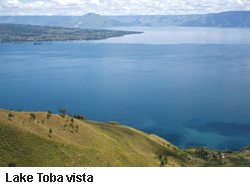 The bus from Lingga roared through gentle glades snuggled between thickly-wooded mountains. In this picturesque villagescape, men and women worked rice fields and orange orchards or walked the roads with bamboo baskets laden with fruit, vegetables and orchids slung over their shoulders; village lads hailed passing vehicles to tout exotic turtles, rabbits, guinea pigs and hamsters; old men in broad-brimmed straw hats perched on boulders gazed languidly with fishing rods in their hands. We drove through small market towns where sarong-clad women sat on street corners vending mounds of raw tobacco, dried fish, fresh tofu and bolts of batik. These idyllic villages which so enchanted 19th century European travelers, have lost none of their pristine charm.
The bus from Lingga roared through gentle glades snuggled between thickly-wooded mountains. In this picturesque villagescape, men and women worked rice fields and orange orchards or walked the roads with bamboo baskets laden with fruit, vegetables and orchids slung over their shoulders; village lads hailed passing vehicles to tout exotic turtles, rabbits, guinea pigs and hamsters; old men in broad-brimmed straw hats perched on boulders gazed languidly with fishing rods in their hands. We drove through small market towns where sarong-clad women sat on street corners vending mounds of raw tobacco, dried fish, fresh tofu and bolts of batik. These idyllic villages which so enchanted 19th century European travelers, have lost none of their pristine charm.
After two hours on the road we began to climb through dense equatorial forest. As we drove higher we entered a seemingly endless stretch of pine and fir trees, smudged out of vision by the rapidly rising mist curling up from the valley below. Finally we came upon a small clearing, opening out into the ‘palace’ complex of the Raja. A large structure by traditional Batak standards, it stood on stilts hewed out of thick logs, painted all over with animistic motifs. Although only a one-room structure, it boasted twelve hearths for each of the late Raja’s dozen wives and their children.
A while later, just as our bus took a steep bend, a vast sheet of water spread out before me, stretching to the distant horizon. This was the famed Lake Toba, extending over a staggering 1,265 sq. km and one of the largest freshwater lakes of South-east Asia. Almost a kilometre deep in some stretches, it fills the enormous crater of an extinct volcano. From our higher level perspective it seemed a vast sea, its far end completely hidden from view, its waters dead still. A couple of country boats bobbed up and down just off the near bank. From the jagged edges of the volcano, several waterfalls cascaded into the lake. Beneath heavy cloud cover in the middle of the lake, the thickly forested Pulau Samosir island (pop. 15,000) was where the quaintly-named village of Tuk-Tuk was located. If seclusion was the selling point here, I was glad for having scheduled a fortnight’s stay in this Sumatran lake district.
The bus dropped me off at the township of Parapet, where I had just about enough time for a bowl of noodle soup before catching a ferry heading across the lake to Tuk-Tuk, a half-hour ride to the south. By this time, the placid waters of Lake Toba had turned choppy as cold winds whistled down the slopes of the volcano ringing the lake. Soon, it began to pour, and our little boat heaved about but made its cautious way towards Tuk-Tuk with considerable difficulty, even as a band of chain-smoking Batak seminary students strummed guitars and sang with abandon, right through the fierce tropical storm.
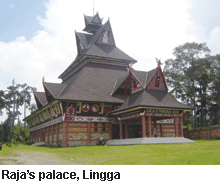 As we neared Pulao Samosir, the clouds lifted, unveiling a tropical island paradise. Nature here is lush and extravagant: gentle mountain slopes covered with pine, verdant meadows dotted with livestock; tiny cottages with red tiled roofs surrounded by flowering trees and dwarf palms. Architecturally, Batak houses on stilts are interspersed with Dutch-style cottages and churches with narrow steeples, as if miraculously transported onto this island all the way from northern Europe.
As we neared Pulao Samosir, the clouds lifted, unveiling a tropical island paradise. Nature here is lush and extravagant: gentle mountain slopes covered with pine, verdant meadows dotted with livestock; tiny cottages with red tiled roofs surrounded by flowering trees and dwarf palms. Architecturally, Batak houses on stilts are interspersed with Dutch-style cottages and churches with narrow steeples, as if miraculously transported onto this island all the way from northern Europe.
I got off the ferry onto a wharf from where a narrow cobbled lane lined with tropical trees, led up to a hillock. I trudged into the village checking out lodgings on offer. The choice was wide because Tuk-Tuk is a favoured destination of Western backpackers touring South-east Asia. But when I was visiting in 2006, business was slow with the economic crisis of 2005-06 having hit Indonesia’s tourism industry hard.
After considerable negotiation I checked into Libertas, a cozy inn comprising six tastefully designed Batak-style log houses, sited on the shore of Lake Toba. Libertas Inn offered a blooming garden of orchids, herbs, creepers and plants with leaves the size of elephant ears. It boasted its own private jetty as well as a canopy built on an islet off shore. Mr. Moon, the amiable proprietor, was also a skilled chef and it was from him that I discovered to my pleasant surprise that Indonesian food is more varied than just noodles, soup and fish. This five-star accommodation came with a price tag of Rupiah 60,000, which to my great relief translated into a modest Rs.250 per day.
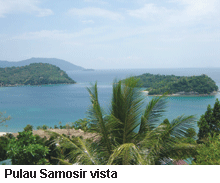 Of all the exotic destinations I’ve visited across continents and coun-tries, I can’t recall a more scenic locale offering such splendid isolation. No automotive inter-vention is permitted within the village and its environs. It was the perfect place for me to finish the book I was working on. After a week’s hibernation on the edge of Lake Toba, I set about exploring the island.
Of all the exotic destinations I’ve visited across continents and coun-tries, I can’t recall a more scenic locale offering such splendid isolation. No automotive inter-vention is permitted within the village and its environs. It was the perfect place for me to finish the book I was working on. After a week’s hibernation on the edge of Lake Toba, I set about exploring the island.
I spent several afternoons sauntering through Tuk-Tuk and neighbouring settlements, stopping at craftsmen’s shops and watching them turn wooden logs into exquisitely carved artifacts; haggling with friendly village women over the price of fruits and carrots which they wheeled around in barrows, or simply chilling in eateries, sipping Chinese tea and meditating in gentle sunshine. There is nothing so good for tired body and soul as paddling one’s feet in warm waters while watching huge fish leaping about, water spiders gliding busily and electric blue and green dragonflies and bird-size butterflies buzzing overhead, even as flights of migrant duck and stork fanned out, heading home in geometric formation.
The larger island of Pulau Samosir was even more scenic and serene. Emerald paddy fields stretched along the base of a long mountain chain which divided the island into two. The paddy fields are ringed with cocoa and orange trees, interspersed with tombs featuring Christian and animist motifs, as Bataks bury their dead in their own fields, probably to remain close to their spirits.
Five km north of Lake Toba lies the village of Tomok, housing the royal cenotaphs of the Sidabutar Rajas, one of the several families of hereditary chieftains who had divided the island among themselves. Massive red stone tombs stand over their graves, shaped like reclining men and women with over-sized, almost comic, faces. Carved totem poles offer evidence of lingering animism. Alongside, a row of wooden crosses are testimony to the new faith rapidly spreading among the Bataks, who increasingly accept Christianity as more modern than their ancestral faiths. Stalls sell fine handicrafts — hand-woven fabrics, tribal masks, black magic wands and utensils made of bamboo and leaves. A group of women dressed in traditional finery sang hymns and clapped hands. It was Easter Sunday, and the denizens of Tomok were in a celebratory mood.
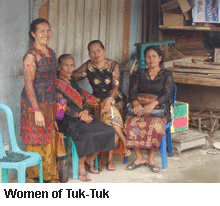 Easter festivities were also on at the village of Simanindo, 20 km down the road, offering an odd admixture of animism with a thin veneer of Christianity. At the erstwhile royal complex there, young men and women sang Easter hymns sprinkled with Indonesian rock-and-roll. Simultan-eously the local bomoh or witch-doctor performed an energetic dance before the towering totem pole in front of the Raja’s erstwhile palace — a small, one-roomed hut. Likewise, similar festivities were being held in the royal complex of the Rajas of Ambarita some miles away. On furniture once used by royalty to feast upon the bodies of executed criminals, young children nibbled factory-made Easter eggs.
Easter festivities were also on at the village of Simanindo, 20 km down the road, offering an odd admixture of animism with a thin veneer of Christianity. At the erstwhile royal complex there, young men and women sang Easter hymns sprinkled with Indonesian rock-and-roll. Simultan-eously the local bomoh or witch-doctor performed an energetic dance before the towering totem pole in front of the Raja’s erstwhile palace — a small, one-roomed hut. Likewise, similar festivities were being held in the royal complex of the Rajas of Ambarita some miles away. On furniture once used by royalty to feast upon the bodies of executed criminals, young children nibbled factory-made Easter eggs.
That fortnight on Pulau Samosir was one of the highlights of my travels in remotest Sumatra. Yet more adventure awaited me in the north, in the province of Aceh, troubled by civil war. With fear in my heart but the spirit willing, I headed there.